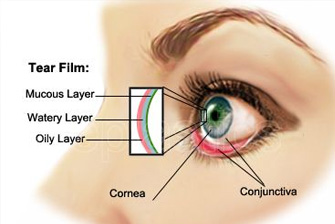DRY EYE SYNDROME
 Dry eye is a very common eye condition which is often under diagnosed. Dry eye occurs when people don’t have either enough tears, or the correct composition of tears, on the surface of their eyes to lubricate the eyes and keep them comfortable.
Dry eye is a very common eye condition which is often under diagnosed. Dry eye occurs when people don’t have either enough tears, or the correct composition of tears, on the surface of their eyes to lubricate the eyes and keep them comfortable.
Normal tear film
Tears secreted in our eyes are very essential for the maintenance of eye health. The tear film is made up of a inner mucous layer (helps spread the tears), a middle water layer, and an outer oily layer (prevents evaporation of tears). All three components are critical to a normal tear film. If any of the three layers of the tear film are deficient, the person may suffer symptoms of dry eye.
Who's at risk for Dry Eye?
Men and women of any age may develop Dry eyes . However certain factors are known to have a higher risk for developing Dry eye.
- Aging: Advancing age is the single most important risk factor for Dry Eye. Dry Eye Syndrome affects 75% of the population over the age of sixty-five years.
- Women: Hormonal changes brought on by pregnancy, lactation, oral contraceptives, menstruation, and post-menopause can cause Dry Eye conditions.
- Disease: Several diseases result in side affects of Dry Eye Syndrome: Rheumatoid Arthritis, Diabetes, Thyroid Abnormalities, Asthma, Cataracts, Glaucoma, Lupus.
- Medication: Certain medications can decrease the body’s ability to produce lubricating tears: Antidepressants, decongestants, antihistamines, blood pressure medication, oral contraceptives, diuretics, ulcer medication etc.
- Contact Lenses: Dry Eye is the leading cause of contact lens discomfort or intolerance. Soft contacts, in particular, rapidly evaporate the tears from the eye, causing irritation, protein deposits, infection, and pain.
- Environmental Conditions: Exposure to smoke, fluorescent lights, air pollution, wind, heat, air conditioning, and dry climates can increase tear evaporation.
- Computer Users: Computer users spend hours staring at their terminal ignoring their normal blinking process, which is a vital function of tear production.
- Refractive Surgery: Candidates considering refractive surgery (eg. LASIK) should consult their Eye Doctor regarding any dry eye risks associated with the procedure.
What are the symptoms of dry eyes?
If you have dry eye, your eyes can feel persistently gritty, itchy, burning, and painful. These sensations often worsen as the day goes on. Stringy mucus may appear in or around the eyes. Paradoxically some may experience excess watering of the eyes. This is due to increased stimulus to produce more tears. Patients with the most severe disease are at increased risk of developing corneal infection, scarring or ulceration. These conditions can cause permanent vision loss, so it is important to seek professional help if you have severe symptoms of dry eye
What tests are necessary for a diagnosis of Dry Eye?
Tests for dry eyes can be performed through several methods. One of the simplest, Schirmer's test, is performed by placing a small piece of filter paper inside the lower part of the eyelids. The eyes are closed for a few minutes and taken out to measure the amount of tear production. Fluorescein eye drops may also be used to determine tear production. The special eye drops contain a dye that can be traced with a special light as it is washed out of the eyes by the tears. Tears may also be examined to see if they contain enough moisture, proteins, and other materials.
If autoimmune diseases are suspected as a cause of Dry eyes, blood tests may be performed. These blood tests check for the presence of different autoantibodies that may be associated with Dry eyes.
How is Dry Eye Syndrome Treated?
Depending on the causes, Dry Eye Syndrome can be treated as a temporary problem or a lifelong disease requiring long-term treatment. Either way, tears must be conserved or replaced in order to provide relief.
Replacing the Tears:
The first line of treatment is usually eye drops that act as artificial tears ( to replace the natural tears) and give some temporary relief. These solutions and ointments give some temporary relief, but do little to arrest or reverse any damaging conditions. The preservatives in some eye drops can irritate the eye; preservative-free artificial tears may be required.
Conserving the Tears:
In cases of persistent Dry Eye symptoms, permanent, reversible closure of the tear duct or punctal occlusion, may be the best solution. Punctal occlusion allows you to retain your own, natural tears without the bother or expense of constantly replacing the tear film with artificial tears
Other treatments:
Cyclosporine A eye drops helps decrease any inflammation on the surface of your eye. This inflammation is thought to decrease the ability of your eyes to maintain a healthy tear film.
Treatment of the underlying cause :
Correcting the underlying cause wherever possible will improve the symptoms. Often dry eyes may be an early indicator for other systemic disorders & hence thorough evaluation is necessary.
Are there any other modifications in life style necessary?
To help alleviate your symptoms from DES, you may want to try these self-help tips at home.
- A humidifier puts more moisture in the air. With more moisture in the air, your tears evaporate more slowly, keeping your eyes more comfortable. air conditioning decreases the humidity in the air & increases dryness.
- Excessive air movement dries out your eyes. Avoid having excessive air movement by decreasing the speed of ceiling fans and/or oscillating fans.
- If you notice your eyes are dry mainly while you are reading or watching TV, taking frequent breaks to allow your eyes to rest and become moist and comfortable again is helpful.
- Drink plenty of water
- If you are using contact lenses consult your eye doctor regarding the safety.

